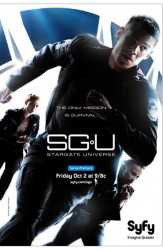The following excerpt, featured in the latest issue of The Official Stargate SG-1/Atlantis Magazine, begins with co-creator/executive producer Brad Wright explaining why the series opener Air took some creative engineering to pull off…
 “Originally, the story was supposed to be a two-parter. That was the first production challenge,” says Brad Wright. “Robert and I were writing this script together, which came out of a story we’d spun. He had put the story beats down and, as I tried to go through those beats, I realized that these scenes weren’t little, they were huge. I struggled for a while to write certain parts of the script, and finally I emailed Rob and said, ‘We have too much story. We’re never going to get to the planet before the end of part two, especially if we write these scenes the way they should be written.’ “Rob wrote two words back to me, which were ‘three hours’ – and that’s what ended up happening. Obviously, we had to get on the phone and discuss it with Syfy and MGM, and as a result Air has become a two-hour premiere with a cliffhanger, and its resolution is Air Pt. 3.
“Originally, the story was supposed to be a two-parter. That was the first production challenge,” says Brad Wright. “Robert and I were writing this script together, which came out of a story we’d spun. He had put the story beats down and, as I tried to go through those beats, I realized that these scenes weren’t little, they were huge. I struggled for a while to write certain parts of the script, and finally I emailed Rob and said, ‘We have too much story. We’re never going to get to the planet before the end of part two, especially if we write these scenes the way they should be written.’ “Rob wrote two words back to me, which were ‘three hours’ – and that’s what ended up happening. Obviously, we had to get on the phone and discuss it with Syfy and MGM, and as a result Air has become a two-hour premiere with a cliffhanger, and its resolution is Air Pt. 3.
Expanding our story was a function of having such rich characters to play with, and a big, almost epic tale to tell, which required three hours. “It’s not like it’s terribly complicated, though, despite all this talk about beats. Basically, our people are running out of air, and while the solutions are more complex, they need to solve a very elemental problem. That’s true of most of our first season. It’s about survival and just getting to the next day alive. And that’s because our ship, the Destiny, as wonderful and full of technology as it is, is really old. It’s falling apart, and staying alive is going to be a challenge for all our characters.”
 In order to resolve the environmental issue aboard the Destiny, Lt. Scott (Brian J. Smith) leads a team on an off-world mission in Air Pt. 3 in search of calcium carbonate to remove excess CO2 from the ship. Regular viewers of Stargate SG-1 and/or Stargate Atlantis who might be expecting to see the team trudging around ‘familiar surroundings’ are in for a surprise. “We desperately did not want to have our characters running through trees,” insists Wright. “In every other Stargate series we’ve been surrounded by the forests of Vancouver, and this time Charlie Cohen [a senior executive] at MGM said, ‘Well, let’s go somewhere new, then!’ We told him that it would be expensive, and Charlie said, ‘This is a big, important new show for us, so let’s make it work.’ So we shot in the White Sands Desert of New Mexico and it looks like a feature film.
In order to resolve the environmental issue aboard the Destiny, Lt. Scott (Brian J. Smith) leads a team on an off-world mission in Air Pt. 3 in search of calcium carbonate to remove excess CO2 from the ship. Regular viewers of Stargate SG-1 and/or Stargate Atlantis who might be expecting to see the team trudging around ‘familiar surroundings’ are in for a surprise. “We desperately did not want to have our characters running through trees,” insists Wright. “In every other Stargate series we’ve been surrounded by the forests of Vancouver, and this time Charlie Cohen [a senior executive] at MGM said, ‘Well, let’s go somewhere new, then!’ We told him that it would be expensive, and Charlie said, ‘This is a big, important new show for us, so let’s make it work.’ So we shot in the White Sands Desert of New Mexico and it looks like a feature film.
Robert Carlyle [Dr. Nicholas Rush] actually got T-shirts for everyone who went down there with ‘117’ printed on the front because that’s how hot it was! “The footage is magnificent and Andy Mikita, who directed all three parts of Air, did an amazing job. As most people know, he’s been with us for years and once again he absolutely hit it right out of the ball-park. So the New Mexico shoot was another production challenge with Air and very much worth it, but those who were there suffered to get the job done.
Their efforts come out of our desire to tell elemental stories that aren’t about fighting big latex-faced, English-speaking bad guys. That’s the major difference between this show and the other Stargates. Universe is much more man against nature/man against man and the crises and conflicts are more internal and onboard the ship. It’s human interaction and human conflict as opposed to alien. That’s not to say we’re not going to run into aliens, because we are. They’re just not going to twirl their mustaches and all speak English.”
Read the full story in issue 30 of The Official Stargate SG-1/Atlantis Magazine, now on newsstands